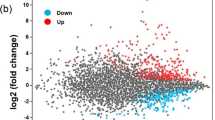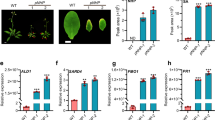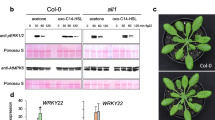Abstract
Production of reactive oxygen species (ROS) is a conserved immune response primarily mediated by NADPH oxidases (NOXs), also known in plants as respiratory burst oxidase homologs (RBOHs). Most microbe-associated molecular patterns (MAMPs) trigger a very fast and transient ROS burst in plants. However, recently, we found that lipopolysaccharides (LPS), a typical bacterial MAMP, triggered a biphasic ROS burst. In this study, we isolated mutants defective in LPS-triggered biphasic ROS burst (delt) in Arabidopsis, and cloned the DELT1 gene that was shown to encode RBOHD. In the delt1-2 allele, the antepenultimate residue, glutamic acid (E919), at the C-terminus of RBOHD was mutated to lysine (K). E919 is a highly conserved residue in NADPH oxidases, and a mutation of the corresponding residue E568 in human NOX2 has been reported to be one of the causes of chronic granulomatous disease. Consistently, we found that residue E919 was indispensable for RBOHD function in the MAMP-induced ROS burst and stomatal closure. It has been suggested that the mutation of this residue in other NADPH oxidases impairs the protein’s stability and complex assembly. However, we found that the E919K mutation did not affect RBOHD protein abundance or the ability of protein association, suggesting that the residue E919 in RBOHD might have a regulatory mechanism different from that of other NOXs. Taken together, our results confirm that the antepenultimate residue E is critical for NADPH oxidases and provide a new insight into the regulatory mechanisms of RBOHD.
抽象
目 的
解析呼吸爆发氧化酶同系物蛋白 D (RBOHD) 介导活性氧迸发的分子机制。
创新点
首次研究 RBOHD 蛋白羧基端在植物体内活性氧迸发中的作用, 并对其机制进行初步探究。
方法
本文利用正向遗传学方法筛选得到在多种病原物相关分子模式 (PAMP) 处理后活性氧不迸发的突变体delt。然后结合图位克隆和全基因测序技术, 发现 DELT1 编码了 RBOHD 蛋白。DELT1-2 在 RBOHD 羧基端倒数第三位谷氨酸位置发生了突变。深入分析发现, 谷氨酸的突变不影响 DELT1-2 表达、蛋白定位和互作等功能, 但会导致植物不响应 PAMP 诱导的气孔关闭。
结 论
RBOHD 羧基端倒数第三位谷氨酸对其功能发挥起着决定作用。
Similar content being viewed by others
References
Antolín-Llovera M, Ried MK, Binder A, et al., 2012. Receptor kinase signaling pathways in plant-microbe interactions. Annu Rev Phytopathol, 50:451–473. https://doi.org/10.1146/annurev-phyto-081211-173002
Baker CJ, Orlandi EW, 1995. Active oxygen in plant pathogenesis. Annu Rev Phytopathol, 33:299–321. https://doi.org/10.1146/annurev.py.33.090195.001503
Bedard K, Krause KH, 2007. The NOX family of ROS-generating NADPH oxidases: physiology and pathophysiology. Physiol Rev, 87(1):245–313. https://doi.org/10.1152/physrev.00044.2005
Bedard K, Lardy B, Krause KH, 2007. NOX family NADPH oxidases: not just in mammals. Biochimie, 89(9):1107–1112. https://doi.org/10.1016/j.biochi.2007.01.012
Boller T, Felix G, 2009. A renaissance of elicitors: perception of microbe-associated molecular patterns and danger signals by pattern-recognition receptors. Annu Rev Plant Biol, 60:379–406. https://doi.org/10.1146/annurev.arplant.57.032905.105346
Calcaterra NB, Pico GA, Orellano EG, et al., 1995. Contribution of the FAD binding site residue tyrosine 308 to the stability of pea ferredoxin-NADP+ oxidoreductase. Biochemistry, 34(39):12842–12848. https://doi.org/10.1021/bi00039a045
Cao YR, Liang Y, Tanaka K, et al., 2014. The kinase LYK5 is a major chitin receptor in Arabidopsis and forms a chitin-induced complex with related kinase CERK1. eLife, 3:e03766. https://doi.org/10.7554/elife.03766
Chen DQ, Cao YR, Li H, et al., 2017. Extracellular ATP elicits DORN1-mediated RBOHD phosphorylation to regulate stomatal aperture. Nat Commun, 8(1):2265. https://doi.org/10.1038/s41467-017-02340-3
Chen F, Haigh S, Yu YF, et al., 2015. Nox5 stability and superoxide production is regulated by C-terminal binding of Hsp90 and CO-chaperones. Free Radical Biol Med, 89:793–805. https://doi.org/10.1016/j.freeradbiomed.2015.09.019
Chinchilla D, Zipfel C, Robatzek S, et al., 2007. A flagellin-induced complex of the receptor FLS2 and BAK1 initiates plant defence. Nature, 448(7152):497–500. https://doi.org/10.1038/nature05999
Choi J, Tanaka K, Liang Y, et al., 2014. Extracellular ATP, a danger signal, is recognized by DORN1 in Arabidopsis. Biochem J, 463(3):429–437. https://doi.org/10.1042/bj20140666
Debeurme F, Picciocchi A, Dagher MC, et al., 2010. Regulation of NADPH oxidase activity in phagocytes: relationship between FAD/NADPH binding and oxidase complex assembly. J Biol Chem, 285(43):33197–33208. https://doi.org/10.1074/jbc.m110.151555
Dodds PN, Rathjen JP, 2010. Plant immunity: towards an integrated view of plant-pathogen interactions. Nat Rev Genet, 11(8):539–548. https://doi.org/10.1038/nrg2812
Doke N, 1983. Involvement of superoxide anion generation in the hypersensitive response of potato tuber tissues to infection with an incompatible race of Phytophthora infestans and to the hyphal wall components. Physiol Plant Pathol, 23(3):345–357. https://doi.org/10.1016/0048-4059(83)90019-x
Dubiella U, Seybold H, Durian G, et al., 2013. Calcium-dependent protein kinase/NADPH oxidase activation circuit is required for rapid defense signal propagation. Proc Natl Acad Sci USA, 110(21):8744–8749. https://doi.org/10.1073/pnas.1221294110
Heyworth PG, Cross AR, Curnutte JT, 2003. Chronic granulomatous disease. Curr Opin Immunol, 15(5):578–584. https://doi.org/10.1016/S0952-7915(03)00109-2
Kadota Y, Sklenar J, Derbyshire P, et al., 2014. Direct regulation of the NADPH oxidase RBOHD by the PRR-associated kinase BIK1 during plant immunity. Mol Cell, 54(1):43–55. https://doi.org/10.1016/j.molcel.2014.02.021
Kadota Y, Liebrand TWH, Goto Y, et al., 2019. Quantitative phosphoproteomic analysis reveals common regulatory mechanisms between effector- and PAMP-triggered immunity in plants. New Phytol, 221(4):2160–2175. https://doi.org/10.1111/nph.15523
Kawahara T, Quinn MT, Lambeth JD, 2007. Molecular evolution of the reactive oxygen-generating NADPH oxidase (Nox/Duox) family of enzymes. BMC Evol Biol, 7:109. https://doi.org/10.1186/1471-2148-7-109
Kawahara T, Jackson HM, Smith SM, et al., 2011. Nox5 forms a functional oligomer mediated by self-association of its dehydrogenase domain. Biochemistry, 50(12):2013–2025. https://doi.org/10.1021/bi1020088
Knight H, Knight MR, 1995. Recombinant aequorin methods for intracellular calcium measurement in plants. Methods Cell Biol, 49:201–216. https://doi.org/10.1016/s0091-679x(08)61455-7
Kuhns DB, Alvord WG, Heller T, et al., 2010. Residual NADPH oxidase and survival in chronic granulomatous disease. N Engl J Med, 363(27):2600–2610. https://doi.org/10.1056/NEJMoa1007097
Lamb C, Dixon RA, 1997. The oxidative burst in plant disease resistance. Annu Rev Plant Physiol Plant Mol Biol, 48: 251–275. https://doi.org/10.1146/annurev.arplant.48.1.251
Lambeth JD, 2004. NOX enzymes and the biology of reactive oxygen. Nat Rev Immunol, 4(3):181–189. https://doi.org/10.1038/nri1312
Leben R, Ostendorf L, van Koppen S, et al., 2018. Phasor-based endogenous NAD(P)H fluorescence lifetime imaging unravels specific enzymatic activity of neutrophil granulocytes preceding NETosis. Int J Mol Sci, 19(4):1018. https://doi.org/10.3390/ijms19041018
Leto TL, Morand S, Hurt D, et al., 2009. Targeting and regulation of reactive oxygen species generation by Nox family NADPH oxidases. Antioxid Redox Signal, 11(10): 2607–2619. https://doi.org/10.1089/ars.2009.2637
Li L, Li M, Yu LP, et al., 2014. The FLS2-associated kinase BIK1 directly phosphorylates the NADPH oxidase RbohD to control plant immunity. Cell Host Microbe, 15(3): 329–338. https://doi.org/10.1016/j.chom.2014.02.009
Liang Y, Cao YR, Tanaka K, et al., 2013. Nonlegumes respond to rhizobial Nod factors by suppressing the innate immune response. Science, 341(6152):1384–1387. https://doi.org/10.1126/science.1242736
Liao DH, Cao YR, Sun X, et al., 2017. Arabidopsis E3 ubiquitin ligase PLANT U-BOX13 (PUB13) regulates chitin receptor LYSIN MOTIF RECEPTOR KINASE5 (LYK5) protein abundance. New Phytol, 214(4):1646–1656. https://doi.org/10.1111/nph.14472
Liu YK, He CZ, 2016. Regulation of plant reactive oxygen species (ROS) in stress responses: learning from AtRBOHD. Plant Cell Rep, 35(5):995–1007. https://doi.org/10.1007/s00299-016-1950-x
Macho AP, Zipfel C, 2014. Plant PRRs and the activation of innate immune signaling. Mol Cell, 54(2):263–272. https://doi.org/10.1016/j.molcel.2014.03.028
Magnani F, Nenci S, Fananas EM, et al., 2017. Crystal structures and atomic model of NADPH oxidase. Proc Natl Acad Sci USA, 114(26):6764–6769. https://doi.org/10.1073/pnas.1702293114
Marino D, Dunand C, Puppo A, et al., 2012. A burst of plant NADPH oxidases. Trends Plant Sci, 17(1):9–15. https://doi.org/10.1016/j.tplants.2011.10.001
Mehdy MC, 1994. Active oxygen species in plant defense against pathogens. Plant Physiol, 105(2):467–472. https://doi.org/10.1104/pp.105.2.467
Melotto M, Underwood W, Koczan J, et al., 2006. Plant stomata function in innate immunity against bacterial invasion. Cell, 126(5):969–980. https://doi.org/10.1016/j.cell.2006.06.054
Mittler R, Vanderauwera S, Suzuki N, et al., 2011. ROS signaling: the new wave? Trends Plant Sci, 16(6):300–309. https://doi.org/10.1016/j.tplants.2011.03.007
Niesner R, Narang P, Spiecker H, et al., 2008. Selective detection of NADPH oxidase in polymorphonuclear cells by means of NAD(P)H-based fluorescence lifetime imaging. J Biophys, 2008, 2008:602639. https://doi.org/10.1155/2008/602639
Oda T, Hashimoto H, Kuwabara N, et al., 2010. Structure of the N-terminal regulatory domain of a plant NADPH oxidase and its functional implications. J Biol Chem, 285(2):1435–1445. https://doi.org/10.1074/jbc.m109.058909
Ogasawara Y, Kaya H, Hiraoka G, et al., 2008. Synergistic activation of the Arabidopsis NADPH oxidase AtrbohD by Ca2+ and phosphorylation. J Biol Chem, 283(14):8885–8892. https://doi.org/10.1074/jbc.m708106200
Peccarelli M, Kebaara BW, 2014. Regulation of natural mRNAs by the nonsense-mediated mRNA decay pathway. Eukaryot Cell, 13(9):1126–1135. https://doi.org/10.1128/EC.00090-14
Qi JS, Wang JL, Gong ZZ, et al., 2017. Apoplastic ROS signaling in plant immunity. Curr Opin Plant Biol, 38: 92–100. https://doi.org/10.1016/j.pbi.2017.04.022
Segal BH, Grimm MJ, Khan ANH, et al., 2012. Regulation of innate immunity by NADPH oxidase. Free Radical Biol Med, 53(1):72–80. https://doi.org/10.1016/j.freeradbiomed.2012.04.022
Shang-Guan K, Wang M, Htwe NMPS, et al., 2018. Lipopolysaccharides trigger two successive bursts of reactive oxygen species at distinct cellular locations. Plant Physiol, 176(3):2543–2556. https://doi.org/10.1104/pp.17.01637
Singel KL, Segal BH, 2016. NOX2-dependent regulation of inflammation. Clin Sci, 130(7):479–490. https://doi.org/10.1042/CS20150660
Stasia MJ, Li XJ, 2008. Genetics and immunopathology of chronic granulomatous disease. Semin Immunopathol, 30(3):209–235. https://doi.org/10.1007/s00281-008-0121-8
Sumimoto H, 2008. Structure, regulation and evolution of Nox-family NADPH oxidases that produce reactive oxygen species. FEBS J, 275(13):3249–3277. https://doi.org/10.1111/j.1742-4658.2008.06488.x
Suzuki N, Miller G, Morales J, et al., 2011. Respiratory burst oxidases: the engines of ROS signaling. Curr Opin Plant Biol, 14(6):691–699. https://doi.org/10.1016/j.pbi.2011.07.014
Suzuki N, Koussevitzky S, Mittler R, et al., 2012. ROS and redox signalling in the response of plants to abiotic stress. Plant Cell Environ, 35(2):259–270. https://doi.org/10.1111/j.1365-3040.2011.02336.x
Torres MA, Dangl JL, Jones JDG, 2002. Arabidopsis gp91phox homologues AtrbohD and AtrbohF are required for accumulation of reactive oxygen intermediates in the plant defense response. Proc Natl Acad Sci USA, 99(1):517–522. https://doi.org/10.1073/pnas.012452499
Verhoeven AJ, 1997. The NADPH oxidase: lessons from chronic granulomatous disease neutrophils. Ann N Y Acad Sci, 832:85–92. https://doi.org/10.1111/j.1749-6632.1997.tb46239.x
Vignais PV, 2002. The superoxide-generating NADPH oxidase: structural aspects and activation mechanism. Cell Mol Life Sci, 59(9):1428–1459. https://doi.org/10.1007/s00018-002-8520-9
Zhang MX, Chiang YH, Toruño TY, et al., 2018. The MAP4 kinase SIK1 ensures robust extracellular ROS burst and antibacterial immunity in plants. Cell Host Microbe, 24(3):379–391.e5. https://doi.org/10.1016/j.chom.2018.08.007
Zhang YY, Zhu HY, Zhang Q, et al., 2009. Phospholipase Dα1 and phosphatidic acid regulate NADPH oxidase activity and production of reactive oxygen species in ABA-mediated stomatal closure in Arabidopsis. Plant Cell, 21(8):2357–2377. https://doi.org/10.1105/tpc.108.062992
Zhang ZJ, Peck SC, 2011. Simplified enrichment of plasma membrane proteins for proteomic analyses in Arabidopsis thaliana. Proteomics, 11(9):1780–1788. https://doi.org/10.1002/pmic.201000648
Acknowledgments
We thank Dr. Kun JIANG (College of Life Science, Zhejiang University, Hangzhou, China) for the instruction of the stomatal closure assay.
Author information
Authors and Affiliations
Corresponding author
Additional information
Project supported by the National Natural Science Foundation of China (No. 31622006) and the Postdoctoral Science Foundation of China (Nos. 2018M630683 and 2018T110601)
Contributors
Yan LIANG planned and designed the research; Qiu-ying LI and Ping LI performed most of the experiments; Nang MYINT PHYU SIN HTWE and Ke-ke SHANGGUAN contributed to the cloning of DELT1. Qiu-ying LI and Ping LI wrote the draft manuscript and Yan LIANG revised the manuscript. All authors read and approved the final manuscript. Therefore, all authors have full access to all the data in the study and take responsibility for the integrity and security of the data.
Compliance with ethics guidelines
Qiu-ying LI, Ping LI, Nang MYINT PHYU SIN HTWE, Ke-ke SHANGGUAN, and Yan LIANG declare that they have no conflict of interest.
This article does not contain any studies with human or animal subjects performed by any of the authors.
Electronic supplementary materials
11585_2019_360_MOESM1_ESM.pdf
Antepenultimate residue at the C-terminus of NADPH oxidase RBOHD is critical for its function in the production of reactive oxygen species in Arabidopsis
Rights and permissions
About this article
Cite this article
Li, Qy., Li, P., Htwe, N.M.P.S. et al. Antepenultimate residue at the C-terminus of NADPH oxidase RBOHD is critical for its function in the production of reactive oxygen species in Arabidopsis. J. Zhejiang Univ. Sci. B 20, 713–727 (2019). https://doi.org/10.1631/jzus.B1900105
Received:
Accepted:
Published:
Issue Date:
DOI: https://doi.org/10.1631/jzus.B1900105
Key words
- Reactive oxygen species (ROS)
- NADPH oxidase (NOX)
- Microbe associated molecular pattern (MAMP)
- Lipopolysaccharides (LPS)
- Respiratory burst oxidase homolog D (RBOHD)




